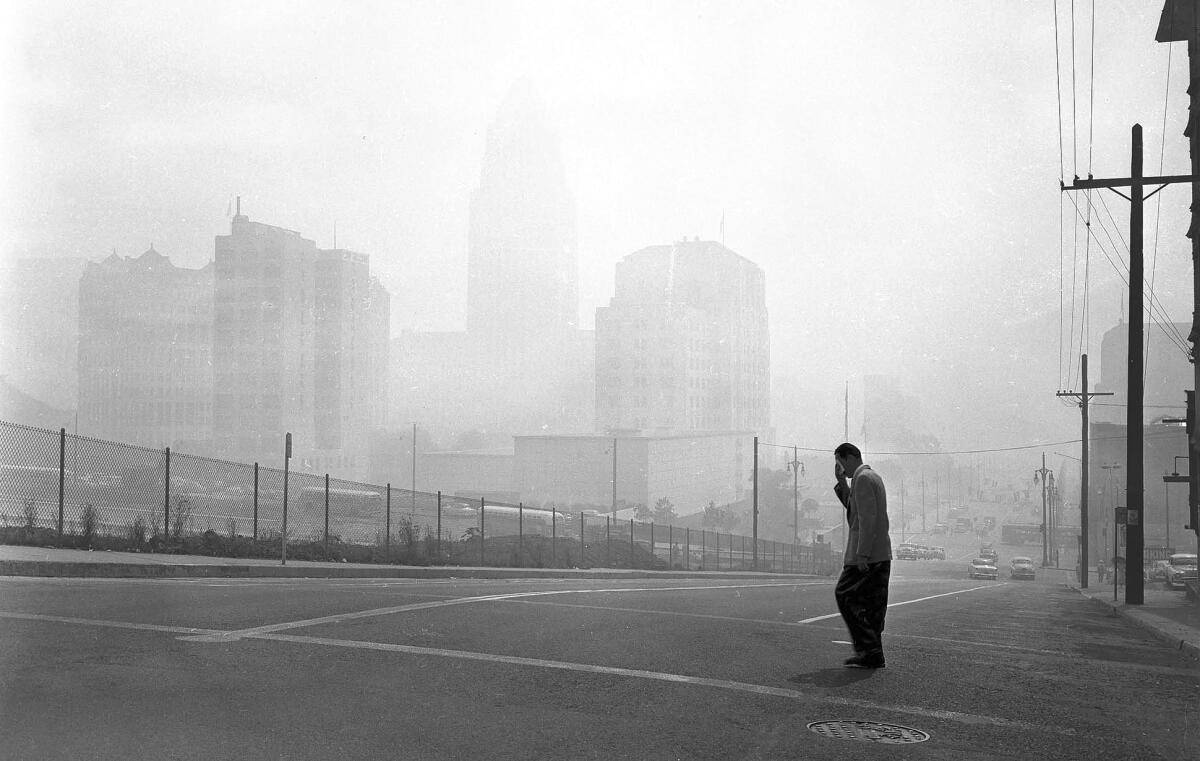California Retrospective: ‘Smog sieges’ often accompanied September heat from the 1950s to ‘80s

- Share via
September has always been a hot month in Southern California.
But for decades, the extreme heat came layered with another form of misery: smog. Through the 1950s to the 1980s, “smog sieges” and “smog attacks” were a part of September life in the L.A. area.
L.A. in the smog, a photo gallery.
Sixty years ago this month, Los Angeles saw what at the time was the highest recorded ozone level in Los Angeles history.
And it was a crisis. As The Times reported at the time:
“The densest smog on record grayed Los Angeles for hours yesterday, threatening closure of industry and curtailment of traffic as ozone concentrations came within a shade of reaching the second alert stage for the first time.
“Another smog assault was forecast for today by the Air Pollution Control District. The prediction was based on a Weather Bureau forecast of another 1000-foot inversion that probably will not lift.
“The APCD said there will be moderate eye irritation in the central area between 9 a.m. and 12:30 p.m. and heavy irritation in the foothill districts between 11 a.m. and 2 p.m.
“The APCD evaluation staff said another first stage alert probably will be called today and urged that householders postpone all backyard burning or other smog-producing activity until the inversion lifts.
“As residents dabbed at their watering eyes yesterday, officialdom’s leaders, admittedly alarmed, waived political differences.
“Gov. Knight, called in Sacramento, placed the California Disaster Committee on an alert stand-by basis.
“Mayor Poulson ordered Chief of Police Parker to cooperate in enforcing Air Pollution Control District emergency regulations and for the initial time, Los Angeles Police Department officers were directed to halt residents from burning combustible waste or from operating backyard incinerators.”
Smog rules were pretty primitive at the time. Officials measured smog levels and if they were bad enough, inspectors stood by at local oil refineries, ready to close them. Truckers were also told to idle their vehicles.
The conditions eventually prompted a ban on backyard debris burning in 1958.
The great smog siege of September 1955 called for some L.A. residents to take extreme measures.
As The Times reported:
“Forty motorcycle riders for a blueprint company late Tuesday went on strike against the smog.
“Henry R. Davis, general manager of the company, said the men told him they refused to ride in smog that was so thick they couldn’t see. Riding one of the two-wheeled speedsters without being able to see, they pointed out, was hazardous.
“Davis promptly went to a war surplus store and purchased 40 gas masks.
“Yesterday, all 40 of the men were back on the job. They roared through downtown streets looking like men from Mars, with gas masks carefully adjusted.
“The masks worked, too, the men said, making seeing possible and breathing more pleasant.
“Davis may have come up with something that will be far-reaching. Policemen working intersections stopped the riders, not to give them citations, but to inquire where they got the gas masks.
“An inquiry to Deputy Chief Harold Sullivan, head of the Traffic Bureau, brought this reply:
“‘We would certainly be interested in anything that would protect the health of our officers and enable them to perform their duties more efficiently.’”
“Who knows, maybe soon motorists will be taking directions from traffic officers in gas masks.”
Over the last four decades, air quality has improved dramatically, thanks to various environmental laws and cleaner technology. But officials say that progress has slowed because of California’s drought.
Experts report that the dry conditions have brought more temperature inversions, with a layer of warmer air trapping cooler air below, concentrating pollution near the ground.
More to Read
Sign up for Essential California
The most important California stories and recommendations in your inbox every morning.
You may occasionally receive promotional content from the Los Angeles Times.













